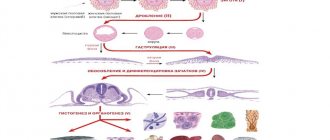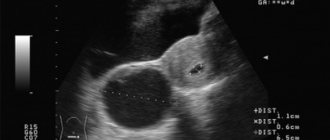The thirteenth week is the beginning of the second trimester of pregnancy, changes are noticeable in the woman’s body: the mammary glands become larger, the growth of the uterus is noticeable. The woman’s general well-being becomes better - her hormonal levels stabilize.
The appearance of discharge at the 13th week of pregnancy may cause minor problems with the intestines and constipation. This is due to the pressure of the uterus and decreased tone in the intestinal muscles. Headaches are a common complaint of women during pregnancy in the second trimester. In this case, it is recommended to rest more often, regularly ventilate the premises, and walk more in the fresh air. If symptoms persist, medical supervision is necessary. Only a doctor can prescribe painkillers that will not harm the fetus and will help the woman.
What are they needed for…
Discharge at the 12th week of pregnancy, as in earlier periods, occurs for the simple reason that nature intended it this way. This mucus is necessary for the formation of a plug. It is she who will protect the unborn baby from penetration of germs and bacteria into the uterus throughout the entire period. The plug will come out just before giving birth.
Discharge at 12 weeks of pregnancy should not bother a woman unless there are additional symptoms. When any other alarming signals occur, you should consult a doctor. A specialist will examine you in a gynecological chair and evaluate your cervical mucus. For a more detailed study, the material is taken for analysis.
Changes in the fetus
The placenta at this time is already fully formed. It actively produces hormones that are required to maintain the full development of the fetus. In addition, the placenta also regulates blood flow to the baby from the mother.
So, at week 14 the following changes occur:
- The thyroid gland creates a special material that enters the mother’s blood and regulates her hormonal balance.
- Children's bodies take on clearer shapes: more pronounced outlines of the face and torso appear.
- In boys, the prostate develops, and in girls, the ovaries descend.
- But the first hairs begin to grow on the baby’s head.
- Blood cells are produced in the bone marrow.
- The baby begins to hear sounds and see light through the stomach. For example, if you direct a bright light to the belly or turn on music, the baby will actively move.
Normal discharge at 12 weeks of pregnancy - what should it be like?
What should cervical mucus be like normally? During pregnancy, the hormone progesterone acts. It is necessary for normal uterine tone. Without it, the reproductive organ will begin to shrink and simply reject the fetus. It is under the influence of this substance that abundant secretion of mucus from the vagina begins. In the first trimester, it has a transparent tint and may stretch slightly. Externally, the mucus looks a little like egg white.
Discharge at 12-13 weeks of pregnancy may change its character somewhat. They take on a whitish or even milky hue. The amount of mucus can be quite copious. This is why gynecologists recommend expectant mothers to use disposable sanitary pads. To avoid the development of infection, they must be changed regularly.
Sex
The sex life of expectant parents at week 13 can sparkle with new colors. By this time, the risk of miscarriage has already been significantly reduced, the woman’s worries and fears have subsided, she has become accustomed to her new condition and, perhaps, even feels the effect of hormones that can significantly increase libido during the period of bearing a baby. The sensitivity of the genital organs also increases, which will allow you to experience new sensations from intimacy with your spouse. Enjoy this blessed time. The only obstacle to this may be your poor health and the threat of miscarriage - in this case it is better not to risk it.
What is characteristic of the 13th week of pregnancy? What to do if brown discharge appears during the 13th week of pregnancy? The answers can be found in this article.
According to experts, in addition to changes in the womb, external changes in her body can also occur. In this article we will look at the issue of discharge during pregnancy at 13 weeks: normal or not.
First of all, it should be noted that discharge even during pregnancy is certainly considered normal. Thanks to them, the woman managed to get pregnant. However, on the other hand, it is important to pay attention to the nature of these discharges, their color, smell and consistency.
The 13th week of pregnancy is usually characterized by a change in the nature of vaginal discharge. From this point on, they may become thinner and probably more abundant. Under no circumstances should you be afraid of this. It is important to ensure that the color and smell of this discharge does not change, but otherwise you should not worry.
The reason for contacting a gynecologist will be brown, cheesy or bloody discharge. In addition, if even ordinary clear discharge begins to be accompanied by itching or severe burning, it is not recommended to leave this issue unattended.
Candidiasis, or fungal infection (thrush) in pregnant women
White discharge at 12 weeks of pregnancy, which is accompanied by a sour odor, itching and the formation of lumps, is thrush. This infection accompanies almost every expectant mother. However, not everyone has it so clearly. Many women do not experience the described discomforts. However, yeast is detected in their smear.
Thrush during pregnancy does not pose a particular threat to the baby. That is why such discharge at 12 weeks of pregnancy is not treated. The correction is postponed until the second third of the term. The optimal time for drug therapy is 16 weeks. It is worth noting that men can be carriers of thrush without having it. That is why both sexual partners should undergo treatment.
Pain and itching
The occurrence of pain is not normal for any person. The reasons for this phenomenon can be very different; only an experienced specialist can find out. This also applies to treatment - depending on the disease, the doctor prescribes treatment individually, taking into account the characteristics of the woman’s body and state of health.
The 13th obstetric week of pregnancy is approaching and your baby is actively growing and developing. Starting from the 11th week of pregnancy from conception, his body will grow rapidly, gradually becoming much larger than his head.
Your future baby can already smell the food his mother is devouring, knows how to put a finger in his mouth (although he cannot suck yet), move his legs and arms, tumble somersaults, and clench his fists.
It's time to communicate with your child: he reacts to stimuli, hears your voice, feels changes in lighting and temperature. Your baby may already frown, smile and yawn.
Infections that are sexually transmitted
Yellow discharge at 12 weeks of pregnancy indicates the presence of infection. At the same time, symptoms such as itching and an unpleasant “fishy” smell appear. Sometimes an increase in body temperature is possible. It is worth noting that this condition is very dangerous for a child. Infection of the membranes and their premature opening are possible.
If you have genital tract infections, you must be tested to determine them. Sensitivity to antibacterial agents is also determined. Only then can suitable medications be prescribed. The ideal option would be to cure the pathology several months before conception, but if this does not happen, then correction is carried out after 18 weeks of pregnancy. Among the safest antibacterial agents are drugs based on amoxicillin. Other drugs are prescribed only when risks and benefits are compared.
What do discharges of this color indicate - reasons that do not pose a danger
Brown discharge is a signal that bleeding is occurring. Pale color indicates minor hemorrhage, while darker colors indicate the source of the blood deep in the vagina. Most likely, the discharge occurs due to increased blood circulation during the period of restructuring.
One of the reasons is injury to the mucous membranes of the genital tract. Brownish masses are due to a genital tract infection not related to position or due to medications.
Often in the 1st trimester of pregnancy, such masses are observed before or after the period of menstruation. The body is actively restructuring, the uterus is filled with blood, detachments of which come out of the vagina.
Hormonal changes in the body
When a girl is pregnant, she begins to experience a series of changes caused by hormonal changes. This process begins naturally, preparing the woman for pregnancy. This is an important stage on which the gestation period will depend.
The amount of hormones produced, for which the endocrine organs are responsible, changes rapidly. The pituitary gland enlarges many times. The genitals undergo the greatest changes, producing estrogen and progesterone. If any process fails during this period, problems may occur.
Implantation of the fertilized egg into the uterine wall
Implantation is the process when the fertilized egg is fixed in the uterus and the processes of fetal development begin. It occurs 7 or more days after fertilization and only if all the conditions for implantation are met.
For this process to be positive, the ovaries must be in a healthy state, and the sperm must have the necessary activity. The girl practically does not feel any changes in her well-being; it is difficult to predict the result of fetal development in the first days of conception. The first symptoms typical of a pregnant woman appear after implantation.
Abnormal periods in the first trimester of pregnancy
Having your period in the first month is common. This happens because the body has not yet had time to rebuild itself and normal physiological processes are taking place in it. While the egg is making its way to the uterus, organ injury is possible.
If conception occurred a week or two before menstruation, the fertilized egg may not have had time to gain a foothold in the uterus. In this case, another period is likely, accompanied by red or brown discharge, which should stop by the 4th week.
Mechanical damage to the integrity of the mucosa
Mechanical damage to the vagina can cause liquid brown and red masses in a woman. They are almost always accompanied by pain and discomfort.
The integrity of the cervix or body of the uterus can be damaged in different ways:
- mechanically;
- chemically;
- thermally;
- radiation.
Often, serious injuries are discovered after medical intervention or blows to the abdominal area. The tissues of the internal organs are torn, opening internal bleeding. This is fraught with serious consequences for the pregnant woman and can provoke a miscarriage at any time.
Pelvic inflammatory processes
Dark discharge at 12 weeks of pregnancy may occur due to an inflammatory process. It is worth noting that most often the pathology spreads to the reproductive organ. As a result, involuntary contractions occur. In some cases, this may pose a risk of miscarriage.
Pathology should always be treated individually. There is no one medicine that suits everyone. In most cases, the inflammatory process in the uterus is eliminated with the help of antimicrobial compounds, vaginal tampons, suppositories and immunomodulatory drugs. However, not all of the listed medications are approved for use by expectant mothers. Often the inflammatory process causes abortion.
What to do
If you notice brown discharge during pregnancy, regardless of whether it is scanty or abundant, immediately call an ambulance or visit a doctor as soon as possible. You should not hope that the discharge will go away on its own. They can be pathological and pose a threat to your life and the embryo.
In the case where dark or light discharge is caused by the attachment of a fertilized egg, no treatment is prescribed. For infrequent bleeding caused by hormonal changes, therapy is not carried out, but the pregnant woman will have to be under the supervision of a specialist to assess the severity of this condition and possible consequences.
Ectopic, threatened miscarriage and other diseases are treated in a hospital setting. Brown secretion at the beginning of pregnancy with such diseases is just a sign. Sometimes home treatment may be prescribed, as well as rehabilitation therapy after hospital treatment.
If pathological discharge appears at the 5th, 6th or 7th week of pregnancy, and is due to the threat of miscarriage, the drug Magne-B6, which contains magnesium and vitamin B6, may be prescribed for treatment. Approximate regimens look like this:
- Take 2 tablets in the morning and evening.
- Take 1 tablet in the morning and lunchtime, 2 tablets in the evening.
The duration of taking the drug is from 14 days and can last until childbirth. Remember, you can only take medication as prescribed by your doctor.
If the discharge occurs due to an ectopic pregnancy, then after its elimination, medication is prescribed to restore the body. They are accepted at home. Drugs are prescribed based on the individual characteristics of the body, among them may be Terzhinan, Bifiform or Phlogenzyme. Approximate regimens:
- 3 tablets of Phlogenzyme three times a day for 3 weeks;
- for 10 days, 1 Terzhinan vaginal suppository at night;
- 1 tablet Bifiform 3 times a day for a week.
Sometimes traditional medicine can be used for treatment, for example, an infusion of hops and oregano. Below is the recipe.
Ingredients:
- oregano - 1 tsp;
- water - 250 ml;
- hops - 1 tsp.
How to cook:
Pour boiling water over dry herbs. Leave for 20 minutes.
How to use:
Drink the infusion twice a day 30 minutes before meals, 0.5 cups.
Remember, any uncharacteristic discharge may be a sign of a serious illness or problems with the course of pregnancy, especially if it is accompanied by severe nagging pain in the lumbar region and lower abdomen. Normal discharge should be clear, not heavy, and odorless. You should tell a specialist about everything else and not self-medicate.
Hormonal imbalances in a woman’s body, or insufficiency of the corpus luteum
Brown discharge at 12 weeks of pregnancy may occur due to a lack of the hormone. Immediately after ovulation, a corpus luteum appears at the site of the burst follicle. It secretes the hormone progesterone. As you already know, this substance is simply necessary to maintain the normal course of pregnancy.
When there is little progesterone, the uterus begins to contract involuntarily. This leads to detachment of the attached fertilized egg. A hematoma forms between the wall of the uterus and the embryo. The larger it is, the less chance of saving the child. This is why you should consult a doctor as soon as possible. Brown discharge is already coagulated blood. That is, the emptying of the hematoma occurred several hours or days ago. It is worth noting that the detachment of the membranes does not always lead to bleeding at the 12th week of pregnancy. The hematoma may not open, but may resolve on its own with appropriate treatment.
Basic examinations at 14 weeks
If the course of pregnancy is stable, the first ultrasound examination is carried out exactly at this stage + - several weeks.
Parents will finally be able to see what a baby looks like at 14 weeks. The reproductive system has already been formed and the gender of the baby can be determined, but it is not always reported. The doctor measures the baby's parameters: suspicion of Down's disease may arise if the nuchal space at 14 weeks is more than 3 mm and there are other signs of the disease. In this case, additional research may be required - placentocentesis. The doctor also determines the position and size of the uterus, assesses the place of attachment of the chorion (future placenta) and its condition, and listens to the heart rate. Deviation from the norm may indicate a congenital heart defect. Also, using an ultrasound, the doctor determines the condition of the umbilical cord and amniotic fluid. If everything is in order, the next ultrasound is scheduled for 20-24 weeks. If there are abnormalities, additional examination or tests may be required. The 15th week of pregnancy will soon come, and by this time all tests should be ready - remember!
Gynecological examination and tissue damage
Pink discharge at 12 weeks of pregnancy may result from a gynecological examination. As a rule, at the end of the first trimester, doctors conduct routine examinations for expectant mothers. Gynecological speculums are used for this purpose. They help assess the condition of the cervix and take the necessary tests.
While expecting a baby, all mucous membranes become more sensitive. That is why the doctor’s careless action may slightly hurt the delicate area. As a result, a small bleeding wound is formed. When droplets of blood mix with normal secretions, they acquire a pinkish tint.
Ultrasound 14 weeks of pregnancy and other tests
If before the 14th week the expectant mother responsibly attended doctor’s appointments and had an ultrasound examination, then by the 14th week all the main tests have already been passed.
Ultrasound 14 weeks of pregnancy and other tests
For control, you can take an open urine test, which is often performed before each doctor’s examination.
During this period, screening examinations are not carried out. Doctors recommend undergoing an ultrasound analysis to confirm the absence of pathologies.
Cervical erosion
Bloody discharge at 12 weeks of pregnancy often becomes a sign of erosion. It is worth noting that the woman does not feel any other disturbing symptoms. Usually the discharge increases after sexual intercourse. They are not abundant. The expectant mother may notice only a slight “smudge” on her underwear.
Cervical erosion is a pathology that is obviously not corrected before pregnancy. This is because the remaining scar can negatively affect the dilation of the cervix and cause complications during childbirth. Treatment of erosion is carried out only after delivery, when the mucous membranes and tissues are restored. Often the problem disappears on its own.
What can harm a child?
The mother's placenta completely protects and protects the baby. But at the same time, there are a number of phenomena that have a detrimental effect on the development of the fetus - smoking, alcohol, drugs, etc.
Doctors strictly prohibit smoking at week 14, as well as drinking any alcohol. This can have harmful consequences for your baby. It is also recommended to give up caffeine.
Read another 15 weeks of pregnancy.
Other causes of discharge at 12 weeks
During pregnancy, many women experience urinary incontinence. For some representatives of the fairer sex, this occurs closer to childbirth. Others suffer from the moment of conception. If you find yellowish stains on your underwear, these could be droplets of urine. In this case, correcting the functioning of the reproductive system will not help you. It is worth contacting a urologist and getting recommendations.
Violation of the vaginal microflora can also cause discharge. However, they do not pose any threat to the unborn baby. The situation with bleeding is much more dangerous.
Future mom
Mom's belly is also getting bigger. If this is not the first time you are pregnant, then perhaps this happened in previous weeks. And now the stomach has risen higher and noticeably rounded. You gain extra weight, but for now this is mainly due to increased blood volume. However, the baby actively moves and develops the muscular system, and therefore requires protein from the mother. You may feel constant hunger, but gluttony is highly undesirable now. Know how to properly plan your diet and diet and under no circumstances overeat at night.
Brown discharge at 12 weeks of pregnancy
This symptom is almost impossible not to notice. Most often, a woman discovers brownish mucus on toilet paper, underwear, or while taking a shower. Their intensity can increase with physical activity. Also, such cause-and-effect relationships may not exist.
If you find brown discharge, you need to call a doctor or go to the hospital as soon as possible. The reason for their occurrence may be various changes. Only a specialist can determine your exact problem.
What can cause brown discharge in the 2nd trimester?
The second trimester is a time when any bleeding poses a danger to the well-being of the expectant mother and baby. There are two main reasons for such conditions: placental abruption and placental previa.
Placental abruption
Veronica, 24 years old: “I noticed brown discharge at 20 weeks of pregnancy. At the same time, my lower abdomen aches strangely. Recently I stumbled and fell, hitting my stomach quite hard. What could it be?"
Olga, 36 years old: “I’m 36. I’m expecting my first baby. Hypertensive. There was placental abruption at 10 weeks, then at 16 weeks of pregnancy. Today, at lunchtime again, there was a strange feeling in the lower abdomen, followed by brown discharge (like menstruation, maybe a little less). They took me away in an ambulance. Detachment again. Term 22 weeks. How does this threaten the child?
Inna, 26 years old: “I started bleeding heavily at 25 weeks of pregnancy. He was urgently hospitalized. A 50% placental abruption was diagnosed. The doctors said that now I will be in the hospital under observation all the time. Is this condition really so dangerous?
Placental abruption is a dangerous condition that causes brown discharge in the second trimester, which ends at 28 weeks of pregnancy. In women, abruption is often accompanied by severe bleeding, and the fetus, when this pathology develops, experiences hypoxia and a lack of nutrients, because the placenta does not perform its functions. There is also a feeling of tension and pain in the lower abdomen. Detachment can be triggered by injuries, arterial hypertension, short length of the umbilical cord, and the presence of scars on the body of the uterus. This condition is extremely insidious and requires emergency hospitalization, and sometimes surgical intervention, since after bleeding of this kind the death of the fetus is possible.
Placenta previa
Alla, 26 years old: “I’m in my sixth month. What does brown discharge mean at 26 weeks of pregnancy? I feel the same as always, but today after cleaning I noticed traces of blood on the laundry. At the fifteenth week there was hypertonicity, there was a threat of miscarriage, it was kept in storage, but there was no bleeding. Has anyone experienced bleeding during the second trimester of pregnancy?
Yulia, 24 years old: “We are expecting a baby. Tests were normal, ultrasound showed lateral placenta previa. Is brown discharge normal at 16 weeks of pregnancy with a similar diagnosis? The doctor says that in the last few months I will have to go to the hospital. It's necessary?"
Inga, 22 years old: “The first time I noticed brown discharge was at 17 weeks of pregnancy. They sent me for an ultrasound. It turned out that I had complete placenta previa. I completed a course of treatment in a hospital and felt great. Discharge appeared again at 24 weeks of pregnancy. She was treated at home under her own responsibility. And again discharge at 27 weeks of pregnancy. The doctor insists on putting me in the hospital until the birth. It is necessary?"
Placenta previa is another abnormal condition in which the placenta is abnormally located. It partially or completely covers the uterine os. If the pathology is detected before the sixteenth week, then therapy is often carried out on an outpatient basis. The higher the gestational age, the greater the risk of bleeding. Fetal growth increases pressure on the placenta. Bleeding often occurs suddenly, for example during sleep. The color of the discharge is scarlet, it is liquid, there is no pain. When sneezing, coughing, bowel movements or bladder emptying, blood loss increases. The 24th week of pregnancy is the period when a woman with placenta previa is often hospitalized in a hospital. There, doctors create conditions to preserve the fetus for up to 30 weeks. After the critical period has passed (at about 31 weeks of pregnancy), an emergency caesarean section is often performed.
Both of these conditions pose a real threat. As a rule, they occur in the second trimester of pregnancy. But placental abruption can also occur in the third, and this is no less dangerous.
Why do they appear?
For what reason may an expectant mother have brownish shades of vaginal mucus at 12 weeks? As you already know, this could be a lack of progesterone. It is worth noting that this reason is the most common of all available.
Brown spotting may be a sign of an ectopic pregnancy. In this case, the woman feels severe pain in the lower abdomen (on one side). Weakness and decreased pulse are also noted. Inaction in such a situation can lead to internal bleeding and death.
Such mucus occurs after careless sexual intercourse, since all surfaces in the vagina become especially sensitive. The slightest effort can damage small vessels. In this case, there is no threat to the child.
Brown discharge detected at 12 weeks may appear due to miscarriage. In this case, we are talking about an abortion that has begun. However, doctors assure that at this stage the size of the fetus is very large. Therefore, to cleanse the uterus, a woman will need surgery (curettage).
Fetal development at 14 weeks of gestation
At this stage, the fetus, at 14 weeks of pregnancy, exhibits its motor and facial activity.
- The baby's face becomes more perfect: the eyes come closer together, the ears take their place, the neck stretches, and his small chin rises.
- The primary fluff (lanugo) still covers the baby’s body. By the way, at 14 weeks your baby’s future hair may already be emerging.
- Internal organs work more harmoniously, and the fetus comprehends new actions.
- For chewing and sucking, it trains its lower jaw, sucking a finger, moving its diaphragm, prepares its chest for breathing, swallowing and spitting out amniotic fluid, the baby develops its small lungs.
- The composition of the baby’s blood has not yet been fully formed, but the Rh factor and blood type are already being determined.
- Starting from this period, you can already listen with a stethoscope to how the heart beats.
- Intestinal peristalsis works, from the 14th week the intestines began to move the bile in it.
- The genital organs of future boys and girls are actively developing.
- You are 14 weeks pregnant and the size of the fetus is changing rapidly. Now its weight is approximately 30-40 grams, and its length is 8-10 cm.
Your belly is already beginning to increase significantly, rising higher and becoming noticeably rounder. Don't forget to take a souvenir photo at 14 weeks of pregnancy! By the way, now you are gaining additional weight mainly due to the enlargement of the fetus. At 14 weeks of pregnancy, a photo of the belly will be an unforgettable photo for mommy.
Your baby is actively developing its muscular system and is constantly moving. That is why he now urgently needs protein in sufficient quantities, which he requires from his mother. Don't be surprised by the feeling of constant hunger that may appear.
At the same time, a woman needs to correctly plan her diet to avoid overeating.
What to do if a symptom is detected?
Brown discharge that occurs in the first trimester of pregnancy can be quite dangerous. In some cases, there is a threat to the life of not only the embryo, but also its mother.
If it is possible to terminate a pregnancy, doctors prescribe bed rest and sedatives, which are allowed in such situations. Medicines are also prescribed to help stop the contractility of the uterus. Hormonal preparations based on progesterone are prescribed for any spotting up to 18 weeks of pregnancy.
In case of a pathology such as ectopic pregnancy, the woman receives urgent surgical care. During the operation, the pathological egg is removed and the consequences of its development are eliminated.
Signs of a frozen pregnancy at 14 weeks
- cramping pain that does not go away;
- bloody discharge (precisely red, not yellowish).
All signs must be considered in their entirety and be sure to consult with your gynecologist. Sometimes during a frozen pregnancy there is a sudden cessation of toxicosis, but since it should go away at the end of the 1st trimester, this most often does not indicate complications. Examination by a doctor, hCG test or ultrasound: these are the only methods to reliably determine the norms of pregnancy development.
Brown discharge and forecasts after it
Any discharge during the first trimester of pregnancy should alert the expectant mother. A timely visit to the doctor increases the chance of saving your baby’s life. Remember that you cannot carry out the correction yourself. The use of certain medications can have a very bad effect on your condition. What medications to take and when is the best time to do it is determined by the doctor.
If you contact a specialist in time, the prognosis will be good. Remember that in such situations it is not days that matter, but hours and minutes. If bleeding occurs, it must be stopped as soon as possible.
If a woman is faced with an ectopic pregnancy, the sooner she consults a doctor and receives emergency care, the better the prognosis. Typically, the embryo in such situations attaches to the fallopian tube. Its rupture and subsequent removal reduces your chances of a subsequent pregnancy by about half.
Nature of the discharge
Heavy discharge during the 13th week of pregnancy is normal, but the leucorrhoea should not have a bad smell or color.
If there are foreign inclusions in the leucorrhoea, clots or lumps, as well as an unpleasant odor, you should consult a doctor; perhaps such discharge is pathological.
Brown
The appearance of brown discharge at 13 weeks of pregnancy is not normal. This condition is dangerous and can threaten both the woman and the fetus. It is recommended to start treatment as early as possible to maintain pregnancy.
The most common cause of brownish discharge is placental abruption. This phenomenon is dangerous because the damaged placenta is not able to fully enrich the unborn child with nutrition and oxygen, and bleeding may occur.
The most susceptible to this phenomenon are patients suffering from hypertension or having bad habits, as well as a history of surgical interventions.
The main symptoms of detachment are discharge, which changes color from scanty light brown to heavy blood loss. This pathology is treatable if you consult a doctor in time.
Bloody
The pathology is the appearance of bloody discharge at the 13th week of pregnancy. There are many reasons for this symptom, the most common are:
- Placental abruption or placental previa.
- Mechanical damage to the uterus as a result of a blow or sexual intercourse.
- Tumors.
- Weak vessels.
This condition requires medical intervention, as there is a risk of fetal loss and deterioration in the woman’s health. One of the most common tests prescribed for this symptom is ultrasound. Often a woman is recommended to undergo inpatient treatment, but this measure is not always necessary.
Pink
Pink discharge in the second and third trimester is not normal. If the shade is very pale and the leucorrhoea is not accompanied by discomfort, odor, there is most likely no threat of miscarriage or other pathologies, but even such signs require consulting a doctor.
However, if leucorrhoea appears after stress, minor physical activity, taking a bath or a hot shower, it is a dangerous symptom, which is often accompanied by discomfort, a pungent odor, and pain. Such discharge may become more intense and change color to bright red. In this case, you need to call an ambulance.
Abundant
Excessive leucorrhoea during pregnancy is often normal if it does not have an unpleasant odor and is not accompanied by pain. These symptoms are caused by an increase in estrogen. The mucus becomes more water-like, making the discharge seem copious.
But there are other reasons why the amount of discharge increases:
- Use of medications.
- Fungal diseases of the vaginal mucosa - candidiasis.
- Vaginosis is accompanied by profuse leucorrhoea, which has a strong and unpleasant aroma.
- Erosion of the uterus.
- Allergic reaction of the body.
- Loss of amniotic fluid.
Each of these situations requires medical intervention and treatment. Therapy is prescribed individually exclusively by the attending physician; self-medication in such a situation is unacceptable.
Preventive measures to avoid certain diseases:
- Tampons cannot be used.
- Don't neglect hygiene.
- Use products for intimate hygiene without dyes and fragrances that can cause allergies.
- Douching should not be used.
- You should not wear tight, uncomfortable underwear made of synthetic fabrics.
These preventive measures will help avoid allergies and various bacterial infections, but if symptoms appear, you should consult a gynecologist.
The secret of light yellow color
The appearance of yellow discharge at the 13th week of pregnancy can be normal if the cause of the symptom is the work of the hormone progesterone. However, yellow discharge is not always normal. In some cases, this may be an allergic reaction to various intimate hygiene products. In this case, it is necessary to avoid products with fragrances and dyes, but if the symptoms do not go away, you should consult a doctor. Discharge, which is accompanied by itching, pain when urinating and other unpleasant symptoms, may signal the development of an inflammatory process or infection with an STD.
Yellowish
Yellow discharge at week 13 is not always normal, especially if it causes severe itching and discomfort. Such a symptom can threaten the health of the woman and the fetus, so a pregnant woman should be especially careful about her condition.
Causes of symptoms:
- Allergy. This condition can be triggered by medications or intimate hygiene products containing irritants.
- Inflammation that is caused by infection. Patients with weakened immune systems are most susceptible to such diseases. If a pathology is detected, the doctor individually prescribes medications that cannot harm the fetus.
- Dysbacteriosis. Usually accompanied by an unpleasant odor and discomfort. Additional tests, such as a smear, may be needed to confirm the diagnosis.
If such symptoms appear, you should consult a gynecologist.
Yellow-green secret
Often, the appearance of yellow-green discharge during pregnancy may indicate infection with an STD. Usually this phenomenon is accompanied by itching and irritation in the intimate area.
During pregnancy, this condition is dangerous and can affect the health of the child.
The most common pathologies are trichomoniasis and gonorrhea. In the absence of treatment, the risk of premature birth is high, and children are most often born sick.
Mucous
The appearance of mucus is considered normal in the second trimester; moreover, its absence may indicate the presence of pathology in a woman’s body. This is explained by the fact that mucus performs a protective function in the vagina, creating a barrier that prevents the penetration of harmful microorganisms.
Such mucus should not have any foreign odor and should not bother the expectant mother in any way. It may be abundant and slightly watery, which is acceptable at 13 weeks. However, if there is a strong foreign odor or a change in the color of the discharge, you should contact the antenatal clinic.
White
The appearance of white discharge in some cases is normal, but if an unpleasant odor and discomfort appear, it can signal thrush.
Candidiasis is a fungal disease. It manifests itself as white curdled masses that have a heterogeneous consistency and an unpleasant odor of sour milk. Often this disease is accompanied by severe itching, pain and burning in the intimate area.
This pathology requires treatment, as it has the ability to quickly spread throughout the entire mucosa.
Possible pathological causes
Mechanical damage is dangerous for a woman at any time.
Bruises or ruptures can stop further development of the fetus and have various consequences:
- Freezing of the fetus.
- Miscarriage.
- Premature placental abruption.
- Early birth.
- Death of the fetus in the womb.
- Threat to the life of a pregnant woman, etc.
If sudden bleeding or sharp pain begins, then measures should be taken immediately. Hospitalization in this case is necessary, otherwise the child and mother will die.
Erosion
Cervical erosion occurs in every fourth woman. This is one of the most popular diseases detected in pregnant women. It is a small red ulcer on the uterus.
There are many reasons for erosion:
- congenital pathology;
- gynecological disease;
- HIV infection;
- inflammatory processes;
- mechanical damage;
- bad habits;
- stress, etc.
Ulcers located on the mucous membrane can bleed. Treatment of erosion is necessary, otherwise the consequences will become unpleasant. This diagnosis will lead to pregnancy going wrong, miscarriage or other pathology. The method of treatment depends on the stage of the disease.
Detachment of the fertilized egg
Brownish masses may indicate detachment of the fertilized egg. It is extremely difficult to independently identify such a violation. One of the symptoms is nagging pain in the lower abdomen, like during menstruation.
The fertilized egg is rejected from the chorion, forming a wound. In its place, a hematoma forms, which is harmful to the fetus. Detachment of the fertilized egg can contribute to early miscarriage.
Fetal freezing
Fetal death is the process when a child in the womb, for some reason, stops developing and dies. This phenomenon is possible up to 28 weeks. At later stages this is called fetal death.
Fetal freezing in the early stages can be determined by certain signs:
- The pain in the chest disappears, the swelling in the mammary glands has subsided.
- Disappearance of nausea and vomiting.
- Decreased body temperature.
- Increased body fatigue, drowsiness.
After the fetus freezes, it must be immediately removed surgically, otherwise an inflammatory process will begin in the body. To prevent its occurrence, you need to regularly see a doctor and follow his recommendations.
Ectopic pregnancy
A woman may develop a pathology in the form of abnormal placement of the fetus. This phenomenon is called an ectopic pregnancy. Such a diagnosis can lead to childlessness and even death of a woman.
Her symptoms are similar to those of a normal pregnancy: nausea, vomiting, swelling of the mammary glands, etc. Later, unexpected outpourings of red or brown color appear, and severe pain occurs.
Hydatidiform mole
If the discharge is brown, then one of the reasons is hydatidiform mole. It occurs when female genes are lost and male genes are duplicated, or when an anucleate cell is fertilized by two sperm. This leads to the fact that the trophoblast degenerates into a huge number of small bubbles and the size of the womb increases several times.
Symptoms: nausea, headaches, weakness, secretion is bloody.
Gynecological diseases
Gynecological diseases are a common cause of abnormal pregnancy. The list of pathologies is huge: from minor to deadly. This is one of the causes of bloody spots in the first and second trimester. They can probably be identified with the help of a doctor by conducting a full examination. To exclude the possibility of their occurrence, you need to be constantly monitored in the hospital.
Infections
Infection can easily enter a pregnant woman's body, since during restructuring it becomes more vulnerable to viruses. You can get it sexually, through blood, through the air.
You can detect infections yourself, for example, through the appearance of dirty discharge or pain. The doctor will make an accurate diagnosis after examination. Treatment must be started immediately, since before 12 weeks of pregnancy the fetus begins to form and is not protected from viruses.
Interrupt
Abortion or other method of termination will lead to bleeding. After the fetus is removed from the uterus, the body is in a state of shock, damaged organs bleed for some time.
Scarlet blood on panties (less often dark, almost brown discharge) is the first sign of a miscarriage. It is after these symptoms that spontaneous abortion occurs. It is necessary to urgently seek medical help if such phenomena are detected.











